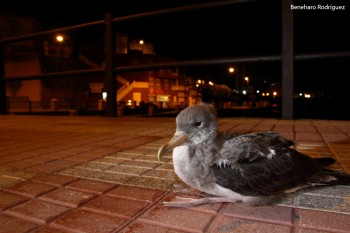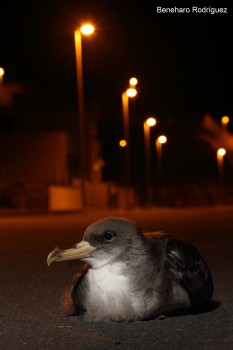Airam Rodríguez (Department of Evolutionary Ecology, Estación Biológica de Doñana, Seville, Spain) and colleagues have reviewed seabird mortality caused by artificial lighting in the journal Conservation Biology. They note that 56 species of petrels and shearwaters are affected.
The paper’s abstract follows:
“Artificial lights at night cause high mortality of seabirds, one of the most endangered groups of birds globally. Fledglings of burrow-nesting seabirds, and to a lesser extent adults, are grounded by lights when they fly at night. We review the current state of knowledge of light attraction, identify information gaps and propose measures to address the problem. Although other avian families such as Alcidae and Anatidae can be involved, the most affected seabirds are petrels and shearwaters: at least 56 species, more than one-third of them (24) threatened, are grounded by lights. Grounded seabirds have been found worldwide, mainly on oceanic islands but also at some continental locations. Petrel breeding grounds confined to formerly uninhabited islands are particularly at risk from ever-growing levels of light pollution due to tourism and urban sprawl. Where it is impractical to ban external lights, rescue programs of grounded birds offer the most immediate and extended mitigation measures to reduce light-induced mortality, saving thousands of birds every year. These programs also provide useful information for seabird management. However, the data typically are fragmentary and often strongly biased so the phenomenon is poorly understood, leading to inaccurate impact estimates. We identified as the most urgent priority actions: 1) estimation of mortality and impact on populations; 2) assessment of threshold light levels and safe distances from light sources; 3) documenting the fate of rescued birds; 4) improvement of rescue campaigns, particularly in terms of increasing recovery rates and level of care; and 5) research on seabird-friendly lights to reduce attraction. More research is necessary to improve our understanding of this human-wildlife conflict and to design effective management and mitigation measures.”


Scopoli's Shearwaters downed by artificial lighting, photographs by Beneharo Rodriguez
Reference:
Rodríguez, A., Holmes, N.D., Ryan, P.G., Wilson, K.-J., Faulquier, L., Murillo, Y., Raine, A.F., Penniman, J., Neves, V., Rodríguez, B., Negro, J.N., Chiaradia, A., Dann, P., Anderson, T., Metzger, B., Shirai, M., Deppe, L., Wheeler, J., Hodum, P., Gouveia, C., Carmo, V., Carreira, G.P., Delgado-Alburqueque, L., Guerra-Correa, C., Couzi, F.-X., Travers, M. & Le Corre, M. 2017. A global review of seabird mortality caused by land-based artificial lights. Conservation Biology DOI: 10.1111/cobi.12900.
John Cooper, ACAP Information Officer, 10 February 2016

 English
English  Français
Français  Español
Español